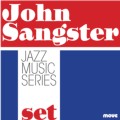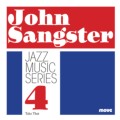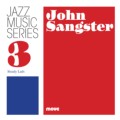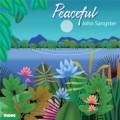
John Sangster
John Sangster was one of the most talented Australian jazz musicians of all time, a technician and creator who embraced and understood more styles of music than any other.
JOHN SANGSTER 1928-1995
John Sangster was one of the most talented of all Australian jazz musicians, a technician and creator who embraced and understood more styles of the music than any other. He was an expert drummer and vibraphone player, a soulful trumpeter and, in arranging and composing, he always took into account the personality of the exponent.
Australian reeds virtuoso Don Burrows wrote in his opening to the forward of Sangster’s autobiography, Seeing the Rafters: “The man is unique”. Unique he was, this drummer, trumpeter, vibraphonist and composer who died in 1995 after a four-year fight with a liver complaint.
In 1992, Sangster was saying with pride that the doctors could hardly discern his liver in their X-rays. In Seeing the Rafters, a quote accompanying a 1950 photo of the Graeme Bell band (in which Sangster was drummer) reads: “Happy days – may we live long and die roaring”. Sangster, bon viveur, lived it up through happy days, nights, months and years.
Sangster came on to the Melbourne jazz scene in 1946, the year of the first Australian Jazz Convention, but it was at the second convention that I first set eye and ear on him as he sat at the piano during a lunch break, playing a slow boogie-woogie piece, diffidently and reflectively but somehow individualistically. It was at the third convention (Prahran Town Hall, 1948) that he made the first of several indelible marks on the Australian jazz scene, playing hot and exiting cornet in a style like that of New Orleans veteran Thomas ‘Papa Mutt’ Carey and he won an award from Graeme Bell as ‘the most promising player’. He first recorded 30 December, and participated in the traditional jazz scene, including through the community centred on the house of Alan Watson in Rockley Road, South Yarra. At the fourth convention, Sangster (or Sango, as he liked to be called) stood one morning with a band in Greville Street, Prahran, playing chorus after chorus of Mahogany Hall Stomp. One afternoon, in a Town Hall backroom, he produced two pieces of wood (whatever they were, they weren’t drumsticks) and beat out a crackling, stimulating rhythm on the back and seat of a wooden chair. Next thing we knew, he had bought the drum set of Russ Murphy, Graeme Bell’s first drummer, and on that kit he recorded on drums for the first time, on a classic revivalist survivalist jazz session led by Roger Bell (youngers brother of Graeme) in mid-winter 1960. The bassist on those records was the powerful – musically and physically – Lou Silbereisen, who had spread the good word about Sangster so that he became the drummer for the second British and European tour of Graeme Bell’s band.
Sangster was now up and away on the international drum scene, recording on drums with black blues singer Big Bill Broonzy in Germany, and recording on trumpet and drums in the Abbey Road studios in London with a combination of the bands of Bell and English trumpet master Humphrey Lyttleton.
In August 1978 Sango was on the television program This is Your Life, in an episode that paid tribute to Graeme Bell. Sango is thanking him for allotting him a trumpet solo on the Bell-Lyttleton recording sessions. We also see Lyttleton that day, waiting to surprise Bell on This is Your Life, saying of Sangster, after seeing him for the first time in twenty-six years: “He’s changed”.
Sangster had changed into the most complete Australian jazz musician, a change that first became apparent after he returned from Japan and Korea with Bell (Sangster’s second overseas tour with him) and came to live in Sydney. He expanded physically and musically. He had never been one of the totalitarian, crushingly restrictive traditionalists, and it was in Sydney that he composed his Hobbit Suite and The Lord of the Rings trilogy – the latter of which has, 25 years later, been re-released on Move. In the musical styles and compositions of these extraordinary works (musical ‘plays’, Sangster used to call them) one catches glimpses not only of the best old Australian jazz tradition of Bell’s early revivalist bands, but also of Thelonious Monk and Dizzy Gillespie, and of Nat and Cannonball Adderley.
At the same time, Sangster the listener was becoming more involved with such avant-garde players as Sun Ra, Archie Shepp and Ornette Coleman, and also with Japanese traditional music, Sangster even taking up the shakuhachi, if only briefly. He also toyed with the idea of scoring for film – a winner, both artistically and financially – and his original scores found their way into the film Fluteman (available on Move) the two well-known Australian television series Peach’s Australia and Harry Butler in the Wild, as well as several animated features and a series of environmental films for the Australian Museum. It is not merely coincidence that Sangster’s concern for the environment would later result in his recording label, Rain-forest Records.
The ever busy Sangster managed to continue to still play with Bell from time to time, but he also worked with the Ray Price Quartet on trumpet and played drums with the Port Jackson Jazz Band. He later played vibes and drums at El Rocco, Brougham Street, Kings Cross, the headquarters of modern jazz in Sydney, with such pianists as Col Nolan and Judy Bailey. He also played drums for a long time with Don Burrows, one of his most ardent admirers, who – to thunderous applause – played the Sangster composition, Rivera Mountain at Carnegie Hall, New York City, in July 1972.
It was with Burrows that Sangster went to Expo 67 in Montreal. We saw him off at Sydney Airport. He wept when I gave him a bulky large type edition of Gracie Field’s Sing as We Go ... not because of the gift or the girl he was leaving behind, but because of the cat he was leaving in his flat above the old El Rocco.
John Grant Sangster, musician/composer, was born 17 November 1928 in Melbourne, only child of John Sangster and Isabella (née Davidson, then Pringle by first marriage). He attended Sandringham (1933), then Vermont Primary Schools, and Box Hill High School. Self-taught on trombone then cornet, learning from recordings with friend Sid Bridle, with whom he formed a band.
Isabella’s hostility towards John and his jazz activities came to a head on 21 September 1946, when she withdrew permission for him to attend a jazz event; in the ensuing confrontation he killed her with an axe but was acquitted of both murder and manslaughter.
He married Shirley Drew 18 November 1949. In 1950 recorded (drums) with Roger, then Graeme Bell, and was invited to join Graeme’s band on drums for their second international tour (26 October 1950 to 15 April 1952). During this tour Sangster recorded his first composition, and encountered Kenny Graham’s Afro-Cubists and Johnny Dankworth, which broadened his stylistic interests.
With Graeme he toured Korea and Japan, 1954 to 1955, then the two worked in Brisbane, where Sangster began playing the vibraphone. Shirley filed for divorce in 1957 (the decree absolute granted 17 September 1959). Bell and Sangster relocated to Sydney from 3 February 1957 for a residency at the Hotel Bennelong. Playing little jazz, the band recorded current skiffle hits (Sangster on washboard), one of which, Rock Island Line, made the top ten, leading to radio/television exposure, and playing support for Johnny Ray’s 1957 Australian tour.
Freelancing from 1959, he also joined Ray Price, Don Burrows and Judy Bailey and became active in music for film and TV. By 1962 he lived in an apartment with his partner, nicknamed Bo Diddley (real name, Janice Patricia Byrnes. Her death at the age of 43 in 1980 inspired Sangster’s the second album in this jazz series Requiem for a Loved One) above the El Rocco, where Sangster became central to jazz experimentation developments. Visiting US pianist Bob James introduced him to avant-gardists Albert Ayler, Sun Ra and Cecil Taylor, expanding Sangster’s music to a degree unequalled in Australian music. On a 1966 ABC broadcast his trio freely improvised over pre-recorded percussion; he was ‘one of only a few composers who used electronic sounds before the 1970s in Australia’.
His participation in Donald Westlake’s 1966 Best of Both Worlds concerts, combining Don Burrows’ Quartet with the New Sydney Woodwind Quartet, included his own compositions. The interest in fusions which informed his experiments with non-Western forms extended to the psychedelic counter-culture, playing in the pit band for Hair from 1969s and at Australia’s first rock festival, at Ourimbah NSW, 1970.
His film music ranged from the experimental (Albie Thoms’ 1969 Marinetti) to children’s animation (Hanna-Barbera’s The Funky Phantom in 1971). His fascination with the musical representation of Australian landscape emerged in his music for the ABC TV series In The Wild (1976-1981). In 1971, moving to Narrabeen, he began composing suites based on Tolkien’s The Lord of the Rings. Between 1973 and 1978 he produced over eight hours of recorded music, spanning ragtime to avant-garde. The instrumentation expanded from the standard traditional jazz lineup to include woodwinds, brass, strings, electric guitars, vocals, synthesiser, and studio-produced effects.
In 1988 he was entered on the Montsalvat Jazz Festival Roll of Honour. He moved to Brisbane in 1992 where he met Berlin-born musician Petra Schnese and the two took up residency as partners. In spite of ill-health he continued performing, including at Wangaratta Jazz and Blues Festival, 1994. His final gig was at Noosa Jazz Party, September 1995. He died of liver cancer on 26 October with Petra at his side. In his honour, and that of both her parents, she later changed her name to Petra Schnese-Kleist-Sangster.
Sangster was central in several major developments in Australian music. Bell’s band was seminal in the formation of an ‘Australian’ jazz sound. Sangster was also at the forefront of progressive jazz movements in Australia: experimental, free-form, electronic and fusions. He had the broadest palette of any Australian performer/composer, with influences ranging from the ‘classic’ jazz corpus to jazz/pop avant-gardists and art music composers, notably Maurice Ravel. The result has been referred to as ‘cosmic dixieland’.
His life and music disclose a far more complex sensibility than the ocker/hobbit persona that he cultivated on stage and in his memoir Seeing The Rafters. He was ‘possibly the most talented of all the musicians who inhabit the jazz world of Australia ... one of the most intuitive musicians Australia has produced in any idiom’.
Compiled from material written by Bruce Johnson, Dick Hughes, Eric Myers, and Mike Williams
Press quotes
“Sangster's career has been an odyssey through the various stylistic movements that characterise Australian Jazz.”
— Eric Myers, NSW National Jazz Co-ordinator
“John Sangster music is highly ambitious and this epic production juxtaposes ragtime, big band and evocative soundtrack-like creations to portray the many characters and events that inhabit Middle Earth ... Essential listening”
— New Classics, UK
“Sangster's enchantment ran deep, and it shows.”
— Chris Seeman, The Tolkien Music List
John Sangster is featured on the following titles
Jazz Music Series (set)
The five volumes of John Sangster's are available individually or as a set for a reduced price.
Jazz music series 5: Ripper
The fifth and final volume in John Sangster's jazz series of Suites that he wrote for a lively little orchestra featuring some of Australia's finest jazz musicians.
Performer: Vibraphone
Composer
Jazz music series 4: Take that
John Sangster's "lively little orchestra", a group of some of Australia's finest jazz musicians, reaches volume four in a series of Suites.
Composer
Jazz music series 3: Steady lads
This is the third in a series of Suites written by John Sangster for a lively little orchestra comprising some of Australia's finest jazz musicians.
Performer: Vibraphone
Composer
Jazz music series 2: Requiem (for a loved one)
Volume 2 out of 5 written by John Sangster and performed by his "fine small orchestra" that includes some of Australia's foremost jazz musicians.
Composer
Jazz music series 1: Don't mean a thing if it ain't got that doo-wup
As John Sangster put it, "Here is the first in a series of Suites written for this lively little orchestra, a gathering that includes some of Australia's finest jazz musicians."
Composer
Meditation
John Sangster, an Australian composer and artist, created an ethereal and haunting musical masterpiece with his album Meditation, originally released on vinyl in 1980. This stunning record features captivating themes played on flute, wind-chime, and marimbas, creating a serene and otherworldly atmosphere.
Performer: Percussion
Composer
Peaceful
Step into the world of jazz with John Sangster's album, Peaceful. This soothing and contemplative album features nine masterfully crafted tracks, each one a fusion of tenor sax, flute, guitar, keyboard, vibraphone, marimba, and other percussion instruments, creating a unique and captivating sound.
Performer: Percussion
Composer
Fluteman
John Sangster composed the music for the little-known film "Fluteman" in 1982. The film may not be high in your mind, but the music performed by Don Burrows (flute), and eight other jazz players makes wonderful listening apart from the film.
Performer: Percussion
Composer
Uttered Nonsense (The Owl and the Pussycat)
Uttered nonsense, (The Owl and the Pussycat), consists eight works of Edward Lear, spoken with the utmost gravity by Mr Ivan Smith, and set to music of the most nonsensical nature by John Sangster.
Performer: Vibraphone, Marimba, Glockenspiel, Swannee-Whistle, Piano, Celeste, Percussion
Composer
Producer
The Last Will and Testament of John Sangster
Tony Gould, Len Barnard, Graeme Lyall and friends. A fitting musical tribute to one of Australia's unsung heroes of jazz - John Sangster - by some of this country's top performers.
Composer
Landscapes of Middle Earth
We complete our restored re-release of John Sangster's jazz-inspired view of Tolkien's epic tale with this the fourth and final work in the series. Originally a double LP released in the late 1970s, this album finally met the CD age late in 2006.
Performer: Vibraphone, Marimba, Percussion
Composer
The Lord of the Rings, Volume 3
This is the third volume of jazz composer John Sangster's classic epic musical interpretation of J.R.R. Tolkien's 'The Lord of the Rings'. Originally a double-LP set issued by EMI over 25 years ago it has never been available on CD until now.
Performer: Keyboards, Percussion
Composer
The Lord of the Rings, Volume 2
Here is the second volume of jazz composer John Sangster's classic epic musical interpretation of The Lord of the Rings. Originally a double-LP set issued by EMI over 25 years ago it has never been available on CD until now.
Performer: Keyboards and Percussion
Composer
The Lord of the Rings, Volume 1
This is not the Howard Shore movie soundtrack but a re-release of jazz/film composer John Sangster's epic attempt to musically portray the events and characters of Tolkien's triology. Not only that, it pre-dates the current film by over 25 years and it's wholly Australian!
Performer: Percussion, Vibraphone, Marimba, Hun0waters, Tambourine, Guiro, Triangles, Brake-drums, Bell-tree, Bamboo, Rattles, Various Wind-chimes, Gongs
Composer
Compositions by John Sangster also appear on
Gould Plays Gould
Some of Australia's finest players of spontaneous, improvised music display their remarkable talents on this disc compiled from two previously released LPs. Conducted by John Sangster.















